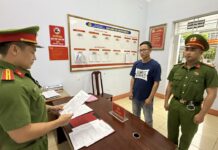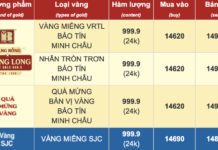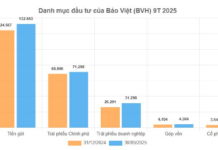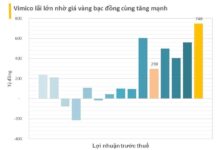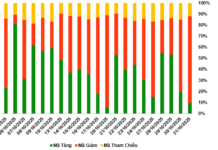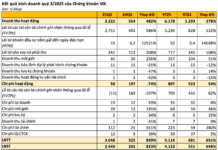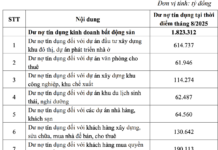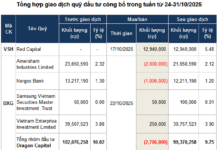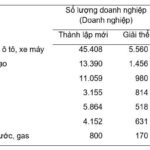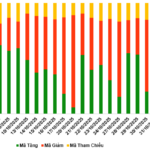 Vietnamese businesses face the challenge of managing foreign exchange rates and maintaining profitability. Image: LÊ VŨ |
Foreign Exchange Losses for Businesses
The trade policies during former U.S. President Donald Trump’s term, coupled with fluctuations in the U.S. dollar, weakened the Vietnamese đồng in the first half of 2025. Additionally, the monetary policy aimed at achieving an 8.3-8.5% GDP growth target for 2025 further increased pressure on exchange rates.
In a recent report, Associate Professor Dr. Vũ Sỹ Cường from the Academy of Finance calculated that the Vietnamese đồng has depreciated by approximately 3.9% against the U.S. dollar since the beginning of the year. Compared to the end of June 2025, the U.S. dollar/Vietnamese đồng exchange rate increased by 0.9%, and the State Bank of Vietnam (SBV) also adjusted the central exchange rate to 25,273 đồng per dollar.
Associate Professor Dr. Vũ Sỹ Cường opined that a weak local currency would also increase import costs for raw materials for manufacturing businesses. Specifically, imports by domestic enterprises have declined for three consecutive months, indicating a decrease in new orders and a pessimistic business sentiment among local manufacturers due to reduced export orders. This situation foreshadows more challenges in the coming months. According to the expert, in the future, cost pressures could erode the advantage of cheap export goods. Inflation may also be pushed higher due to cost-push factors.
In reality, foreign exchange losses have become a genuine concern for many businesses, similar to what happened in 2024. Since the beginning of 2025, a mechanical engineering company in Ho Chi Minh City has incurred foreign exchange losses amounting to tens of billions of đồng due to rate fluctuations. A business in the solar energy sector, which has strategic partnerships with many European equipment and machinery suppliers, is allowed a three-month grace period for payment. Usually, this privilege helps the company be more flexible with payments, taking advantage of the most favorable exchange rates. However, with the developments so far this year, the longer the payment is delayed, the more the company suffers.
|
The SBV should provide clear signals on exchange rate management, such as the expected range of exchange rate fluctuations until the end of the year. This would enable businesses to proactively negotiate contracts and set conditions to minimize risks arising from exchange rate volatility. |
Another Ho Chi Minh City-based company importing machinery and equipment from Europe has only incurred “opportunity costs” so far. They have had to temporarily halt several projects because the estimated investment costs, mainly import costs, have changed significantly. According to the company’s representative, the Net Present Value (NPV) is negative due to increased initial operating costs for the project. If they continue with the project, they will surely incur losses.
Nevertheless, there are bright spots in the picture of Vietnamese exporters in early 2025, with the textile and footwear industries as prime examples. According to data from the Customs Department of the Ministry of Finance, the export value of textiles and garments in the first seven months of 2025 reached $22.59 billion, an increase of 11% (equivalent to an increase of $2.25 billion) compared to the same period last year. For footwear exports, the total export value during the same period reached $14.09 billion, a 9% increase (equivalent to an increase of $1.17 billion) compared to the previous year.
On the import side, in the first seven months of 2025, the import value of raw materials and accessories for the textile and footwear industries reached $16.42 billion, a 4.4% increase, equivalent to an increase of $687 million compared to the same period last year. Thus, from the beginning of 2025, the textile and footwear industries have achieved a trade surplus of over $20 billion. These are the businesses that have benefited from the appreciation of the U.S. dollar against the Vietnamese đồng. Notably, the characteristic of the textile and footwear industries is that they usually import raw materials and accessories at the beginning of the year, so they are not significantly affected by the increasing pressure on exchange rates in recent months.
“However, U.S. importers have been stocking up for the year’s end since the beginning of the year, so orders in the coming months may be more difficult to come by. Additionally, when the U.S. officially imposes countervailing duties on most countries, the prices of products sold in the U.S. will be higher, leading to reduced consumer demand. Therefore, in the remaining months of 2025, exports from Vietnamese textile and footwear companies may not be as favorable as at the beginning of the year,” said Dr. Huỳnh Thanh Điền.
Supporting Businesses
Undoubtedly, the road ahead will be more challenging for business groups that did not have a smooth start, unlike the textile and footwear industries. In a recent report, Professor Dr. Trần Thọ Đạt from the National Economics University assessed that the U.S. dollar/Vietnamese đồng exchange rate could reach higher levels in the third quarter of 2025 if external risks increase. Foreign exchange reserves were estimated at about $80 billion at the end of 2024 but have decreased due to intervention sales. According to the expert, this is an important buffer but needs to be replenished when conditions are favorable.
Dr. Huỳnh Thanh Điền shared a similar view, stating that there is limited room to curb exchange rates in the remaining months of the year compared to the beginning of 2025. Moreover, in the last quarter, the demand for U.S. dollars tends to increase to serve various needs, such as studying abroad and importing goods for the next production cycle.
“To achieve the 2025 growth target and aim for double-digit growth in the following years, monetary policy will continue to be relaxed, focusing on reducing interest rates, which may not help alleviate pressure on exchange rates. The most effective way is to control the total means of payment and use technical tools to regulate the flow of money into the economy’s absorption channels. For production and business sectors, it is necessary to maintain low-interest rates to support sustainable long-term growth. For speculative channels such as securities, real estate, and gold, lending conditions should be tightened to minimize the flow of money into these channels. In other words, credit growth should be directed towards lending to efficient and capable production and business enterprises,” analyzed Dr. Huỳnh Thanh Điền.
To support businesses in overcoming challenges related to exchange rates, Dr. Huỳnh Thanh Điền emphasized the importance of preventing businesses from being caught off guard. Therefore, the SBV should provide clear signals on exchange rate management, such as the expected range of exchange rate fluctuations until the end of the year. This would enable businesses to proactively negotiate contracts and set conditions to minimize risks arising from exchange rate volatility. Fortunately, remittances to Vietnam are high during this period, significantly contributing to increasing the supply of U.S. dollars and reducing the pressure on exchange rates.
“Businesses should also proactively manage exchange rate risks. When signing contracts, if possible, they should make immediate payments to avoid potential rate increases in the coming months. Additionally, businesses can utilize forward contracts to turn future uncertainties into present certainties. With this tool, production costs are predetermined, allowing businesses to organize production, marketing, and sales more efficiently. They may not achieve high profits, but they will avoid significant risks if rates continue to rise,” advised Dr. Huỳnh Thanh Điền.
Khánh Nguyên
– 19:00 12/09/2025
Legal Risk Management: The Ultimate Survival Guide for Businesses in a Tough Economic Climate
At the CEO community forum on the topic of “The Context of Private Economy: The Role of Executives and New Strategies in Enterprise Legal Governance,” held on the afternoon of August 29th, experts shared insights on the challenges faced in today’s business environment. They emphasized the importance of legal risk management and elaborated on the role and strategies for effective governance.
“Unlocking Capital for Businesses: The Government’s Role in Lowering Interest Rates.”
“Vietnamese lawmaker Tran Thi Hien from Ha Nam province urged the government to pay closer attention to the business sector by improving access to capital and reducing interest rates for businesses.”
Prime Minister Postpones Meeting with Chairmen and CEOs of Vingroup, Sungroup, Masan Group, FPT, Hoa Phat, THACO, and T&T on September 12th.
The Prime Minister is keen to host a conference focused on collaborating with private corporations to address challenges in business operations and stimulate economic growth. The aim is to create a platform to discuss strategies for unblocking major projects, fostering a stable macroeconomic environment, and promoting a thriving business landscape.









